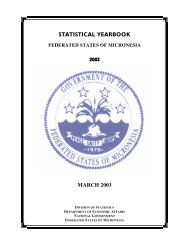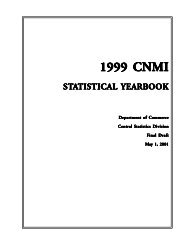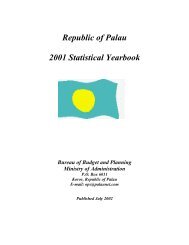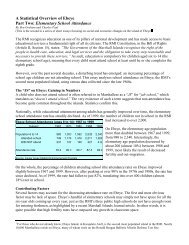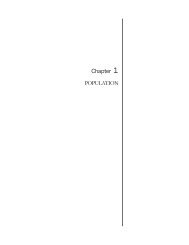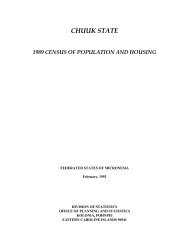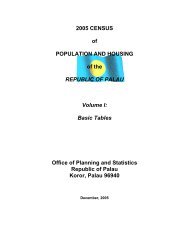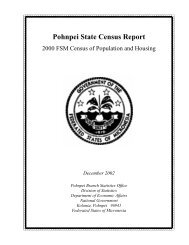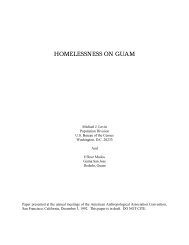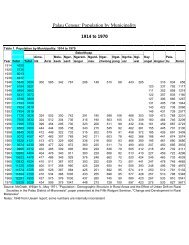Chapter 6. Migration2000 FSM <strong>Census</strong> of <strong>Chuuk</strong> <strong>State</strong>Limitations and Comparability. Due to changes in the boundaries of foreign countries over the past decades, somepersons may have reported their place of birth in terms of boundaries that existed at the time of their birth but havesince changed.Not all migratory moves in the five years before the census were covered. For example, some persons may have residedin the same place in 1994 and 2000 but moved in the interim. This migration was not taken into account. Wherepersons moved more than once in the five years before the census, only the place of residence five years before and thecurrent place of residence were recorded.Analysis of Migration DataThe data from the 2000 <strong>Census</strong> was used to determine the migration patterns in <strong>Chuuk</strong>, including place of birth,citizenship, continuous residence, and residence in 1995. These are compared with the 1989 and 1994 <strong>Census</strong>es (ifavailable) and are also used to analyze the changes that took place over time.BirthplaceBirthplace provides useful data on lifetime migration and mobility patterns, covering an indefinite time interval,determined by people's ages and the timing and direction of movement. Table 6.1 compares the birthplace of <strong>Chuuk</strong>residents in 1989, 1994 and 2000.With few exceptions, the data shows that the overseas-born immigrant population to <strong>Chuuk</strong> was primarily male,especially from other FSM <strong>State</strong>s in 2000 and Asia in 1994 and again in 1989. These differences in sexes could haveimportant implications for future composition of the <strong>Chuuk</strong> population, particularly if the international migration wereto increase. The figures suggest that immigration, particularly from Asia, increased rapidly between 1989 and 1994,but fell in 2000. While the <strong>Chuuk</strong>-born population grew by more than 1 percent (746persons) between census years1994 and 2000, the Asian-born population decreased by more about 90 percent (438 persons) during the same period.Table 6.1: Birthplace of <strong>Chuuk</strong> Residents by Sex: 1989 to 20001989 Males per 1994 Males per 2000 Males perBirthplace Total Males Females 100 females Total Males Females 100 females Total Males Females 100 femalesTotal 47,871 24,203 23,668 102.3 53,319 27,299 26,020 104.9 53,595 27,158 26,437 102.7<strong>Chuuk</strong> 46,829 23,605 23,224 101.6 52,347 26,562 25,785 103.0 53,093 26,846 26,247 102.3Outside <strong>Chuuk</strong> 1,042 598 444 134.7 972 737 235 313.6 502 312 190 164.2Other FSM <strong>State</strong>s 406 221 185 119.5 224 134 90 148.9 192 128 64 200.0USA 232 131 101 129.7 212 118 94 125.5 80 49 31 158.1Asia 69 47 22 213.6 489 454 35 1,297.1 51 38 13 292.3Elsewhere 335 199 136 146.3 47 31 16 193.8 179 97 82 118.3Source: 1989 <strong>Chuuk</strong> <strong>Census</strong>es; 1994 FSM <strong>Census</strong>, Table P17; 2000 FSM <strong>Census</strong>, Table P2-5..Table 6.2 shows place of usual residence by country of birth for 1994 and 2000 to reveal some details aboutinternational migration. In census year 2000, 99 percent of <strong>Chuuk</strong> residents were born in <strong>Chuuk</strong>. The immigrantpopulation accounted for about 1 percent of the total population (a 1 percent drop from 1994). The immigrantpopulation comprised of foreigners (including other FSM <strong>State</strong> persons) and <strong>Chuuk</strong>ese born overseas who had returnedto <strong>Chuuk</strong>. Between 1994 and 2000, the number of foreign-born individuals in <strong>Chuuk</strong> was reduced: Asians by 438,Americans by 132 and other Micronesians <strong>State</strong>s by 32 persons. The only increase was for individuals born‘elsewhere’ by 132 persons. The largest proportion among all the foreign-born people in <strong>Chuuk</strong> at the time of 2000<strong>Census</strong> was from the other FSM states, while during the 1994 <strong>Census</strong> was from Asia, comprised mostly of Chinesebornfishermen.Almost all of the <strong>Chuuk</strong> residents were born in their place of residence. The highest percentage of foreign-born in<strong>Chuuk</strong> Lagoon were those born in other FSM states, accounting for almost half (46 percent) of the foreign-bornpopulation. Similarly, the majority (78 percent) of foreigners in the Outer Islands were born in other FSM <strong>State</strong>s.50 <strong>Chuuk</strong> Branch Statistics Office, Division of Statistics, FSM Department of Economic Affairs
2000 FSM <strong>Census</strong> of <strong>Chuuk</strong> <strong>State</strong>Chapter 6. MigrationTable 6.2: Birthplace of <strong>Chuuk</strong> Residents: 1994 and 2000NumberPercent1994 2000 1994 2000Birthplace Total Lagoon Outer Is.. Total Lagoon Outer Is. Total Lagoon Outer Is. Total Lagoon Outer Is.Total 53,319 41,662 11,657 53,595 40,465 13,130 100.0 100.0 100.0 100.0 100.0 100.0<strong>Chuuk</strong> 52,347 40,756 11,591 53,093 39,986 13,107 98.2 97.8 99.4 99.1 98.8 99.8Lagoon 39,355 39,005 350 38,265 37,936 329 73.8 93.6 3.0 71.4 93.8 2.5Outer Islands 12,992 1,751 11,241 14,828 2,050 12,778 24.4 4.2 96.4 27.7 5.1 97.3Outside <strong>Chuuk</strong> 972 906 66 502 479 23 1.8 2.2 0.6 0.9 1.2 0.2Other FSM state 224 185 39 192 174 18 0.4 0.4 0.3 0.4 0.4 0.1USA 212 188 24 80 79 1 0.4 0.5 0.2 0.1 0.2 …Asia 489 488 1 51 51 - 0.9 1.2 … 0.1 0.1 -China and Taiwan 327 327 - - - - 0.6 0.8 - - - -Philippines 124 124 - 44 44 - 0.2 0.3 - 0.1 0.1 -Other Asia 38 37 1 7 7 - 0.1 0.1 … … … -Elsewhere 47 45 2 179 175 4 0.1 0.1 … 0.3 0.4 …Source: 1994 FSM <strong>Census</strong>, Table P17; 2000 FSM <strong>Census</strong>, Table P2-5.Note: "USA" includes Guam and CNMITable 6.3 shows lifetime interstate migration among the FSM states for 1994 and 2000. The number of <strong>Chuuk</strong>migrants traveling to the other FSM states was greater than the number coming in for both census years. For example,in 2000, 913 lifetime migrants to the three FSM <strong>State</strong>s compared with only 192 migrants to <strong>Chuuk</strong>. On the other hand,in 1994 <strong>Chuuk</strong> lost 665 migrants to the other states, and gained only 224. The majority of the out-migrants in bothcensus years were residing in Pohnpei <strong>State</strong>.In 2000 the direction of migration flow from <strong>Chuuk</strong> was principally towards Pohnpei and Kosrae (Figure 6.1). Thelargest outflow was towards Pohnpei, which gained about 700 people from <strong>Chuuk</strong>.Table 6.3: <strong>State</strong> of Birth of <strong>Chuuk</strong> and other FSM <strong>State</strong>s: 1994 and 2000<strong>State</strong> of Usual Residence in 1994 <strong>State</strong> of Usual Residence in 2000<strong>State</strong> of Birth Total <strong>Chuuk</strong> Yap Pohnpei Kosrae Total <strong>Chuuk</strong> Yap Pohnpei KosraeTotal 102,116 52,571 10,421 32,306 6,818 103,891 53,285 10,404 32,920 7,282<strong>Chuuk</strong> 53,012 52,347 57 588 20 54,006 53,093 47 804 62Yap 10,539 36 10,326 171 6 10,600 59 10,303 224 14Pohnpei 31,595 170 33 31,233 159 32,069 118 51 31,604 296Kosrae 6,970 18 5 314 6,633 7,216 15 3 288 6,910Source: 1994 FSM <strong>Census</strong>es, Table P18; 2000 FSM <strong>Census</strong>, Table P2-5.Figure 6.1 Interstate Lifetime Net-Migration Flows of <strong>Chuuk</strong> and other FSM <strong>State</strong>s, <strong>Chuuk</strong>: 2000.6868173124711 11Table 6.4 shows internal lifetime migration between the Lagoon and Outer Islands. Of the 53,093 persons born in<strong>Chuuk</strong>, 50,714 were non-movers or who resided in their region of birth. The internal lifetime migrants were the 2,395who now resided in a different region than the one in which they were born.The lifetime migration rate column of table 6.4 describes net-migration as a rate, dividing the net-migrants by the totalpopulation. However, since the timing of the migration is undetermined, the rate expressed does not itself relate to anyspecific period, but enables broad comparison between regions. Lifetime internal migration affected both regions indifferent ways. The Lagoon had a lifetime internal migration rate of 4.4 per hundred, while the Outer Islands had alifetime internal migration rate of -12.3 per hundred, showing that the Lagoon is gaining people while the Outer Islands<strong>Chuuk</strong> Branch Statistics Office, Division of Statistics, FSM Department of Economic Affairs 51
- Page 5:
iii
- Page 12 and 13:
Preface2000 FSM Census of Chuukx
- Page 14 and 15:
Table of contents2000 FSM Census of
- Page 16 and 17:
LIST OF TEXT TABLESTABLEPageChapter
- Page 18 and 19:
List of Text Table2000 FSM Census o
- Page 20 and 21:
LIST OF FIGURESFIGUREPageFigure 1.1
- Page 22 and 23:
List of Basic-Tables2000 FSM Census
- Page 24 and 25:
MAP OF FSMxxiiChuuk Branch Statisti
- Page 27 and 28: 2000 FSM Census of Chuuk StateExecu
- Page 29 and 30: CHAPTER 1INTRODUCTIONThe creation o
- Page 31 and 32: 2000 FSM Census of Chuuk StateChapt
- Page 33 and 34: 2000 FSM Census of Chuuk StateChapt
- Page 35 and 36: 2000 FSM Census of Chuuk StateChapt
- Page 37 and 38: 2000 FSM Census of Chuuk StateChapt
- Page 39 and 40: 2000 FSM Census of Chuuk StateChapt
- Page 41 and 42: 2000 FSM Census of Chuuk StateChapt
- Page 43 and 44: 2000 FSM Census of Chuuk State Chap
- Page 45: 2000 FSM Census of Chuuk StateChapt
- Page 48 and 49: Chapter 2. Age and Sex Structure200
- Page 50 and 51: Chapter 2. Age and Sex Structure200
- Page 52 and 53: Chapter 2. Age and Sex Structure200
- Page 55 and 56: CHAPTER 3HOUSEHOLDS, FAMILIES, AND
- Page 57 and 58: 2000 FSM Census of Chuuk StateChapt
- Page 59 and 60: 2000 FSM Census of Chuuk StateChapt
- Page 61: 2000 FSM Census of Chuuk StateChapt
- Page 64 and 65: Chapter 4. Fertility2000 FSM Census
- Page 66 and 67: Chapter 4. Fertility2000 FSM Census
- Page 68 and 69: Chapter 4. Fertility2000 FSM Census
- Page 71 and 72: CHAPTER 5MORTALITYIntroductionAs re
- Page 73 and 74: 2000 FSM Census of Chuuk StateChapt
- Page 75: 2000 FSM Census of Chuuk StateChapt
- Page 80 and 81: Chapter 6. Migration2000 FSM Census
- Page 82 and 83: Chapter 6. Migration2000 FSM Census
- Page 84 and 85: Chapter 6. Migration2000 FSM Census
- Page 86 and 87: Chapter 7. Religion, Ethnicity, and
- Page 88 and 89: Chapter 7. Religion, Ethnicity, and
- Page 90 and 91: Chapter 7. Religion, Ethnicity, and
- Page 92 and 93: Chapter 8. Education2000 FSM Census
- Page 94 and 95: Chapter 8. Education2000 FSM Census
- Page 96 and 97: Chapter 8. Education2000 FSM Census
- Page 98 and 99: Chapter 8. Education2000 FSM Census
- Page 100 and 101: Chapter 8. Education2000 FSM Census
- Page 103 and 104: CHAPTER 9ECONOMIC ACTIVITYIntroduct
- Page 105 and 106: 2000 FSM Census of Chuuk StateChapt
- Page 107 and 108: 2000 FSM Census of Chuuk StateChapt
- Page 109 and 110: 2000 FSM Census of Chuuk StateChapt
- Page 111 and 112: 2000 FSM Census of Chuuk StateChapt
- Page 113 and 114: 2000 FSM Census of Chuuk StateChapt
- Page 115 and 116: 2000 FSM Census of Chuuk StateChapt
- Page 117 and 118: CHAPTER 10INDUSTRY AND OCCUPATIONIn
- Page 119 and 120: 2000 FSM Census of Chuuk StateChapt
- Page 121 and 122: 2000 FSM Census of Chuuk StateChapt
- Page 123 and 124: 2000 FSM Census of Chuuk StateChapt
- Page 125 and 126: 2000 FSM Census of Chuuk StateChapt
- Page 127 and 128: 2000 FSM Census of Chuuk StateChapt
- Page 129 and 130:
CHAPTER 11INCOMEIntroductionThe 200
- Page 131 and 132:
2000 FSM Census of Chuuk StateChapt
- Page 133 and 134:
2000 FSM Census of Chuuk StateChapt
- Page 135 and 136:
2000 FSM Census of Chuuk StateChapt
- Page 137:
2000 FSM Census of Chuuk StateChapt
- Page 140 and 141:
Chapter 12. Housing2000 FSM Census
- Page 142 and 143:
Chapter 12. Housing2000 FSM Census
- Page 144 and 145:
Chapter 12. Housing2000 FSM Census
- Page 146 and 147:
Chapter 12. Housing2000 FSM Census
- Page 148 and 149:
Chapter 12. Housing2000 FSM Census
- Page 150 and 151:
Chapter 12. Housing2000 FSM Census
- Page 152 and 153:
Chapter 12. Housing2000 FSM Census
- Page 154:
Chapter 12. Housing2000 FSM Census
- Page 157 and 158:
BIBLIOGRAPHYArriaga, E.E., (1983).
- Page 159:
2000 FSM Census of Chuuk StateBibli
- Page 162 and 163:
Basic Tables2000 FSM Census of Chuu
- Page 164 and 165:
Basic Tables2000 FSM Census of Chuu
- Page 166 and 167:
Basic Tables2000 FSM Census of Chuu
- Page 168 and 169:
Basic Tables2000 FSM Census of Chuu
- Page 170 and 171:
Basic Tables2000 FSM Census of Chuu
- Page 172 and 173:
Basic Tables2000 FSM Census of Chuu
- Page 174 and 175:
Basic Tables2000 FSM Census of Chuu
- Page 176 and 177:
Basic Tables2000 FSM Census of Chuu
- Page 178 and 179:
Basic Tables2000 FSM Census of Chuu
- Page 180 and 181:
Basic Tables2000 FSM Census of Chuu
- Page 182 and 183:
Basic Tables2000 FSM Census of Chuu
- Page 184 and 185:
Basic Tables2000 FSM Census of Chuu
- Page 186 and 187:
Basic Tables2000 FSM Census of Chuu
- Page 188 and 189:
Basic Tables2000 FSM Census of Chuu
- Page 190 and 191:
Basic Tables2000 FSM Census of Chuu
- Page 192 and 193:
Basic Tables2000 FSM Census of Chuu
- Page 194 and 195:
Basic Tables2000 FSM Census of Chuu
- Page 196 and 197:
Basic Tables2000 FSM Census of Chuu
- Page 198 and 199:
Basic Tables2000 FSM Census of Chuu
- Page 200 and 201:
Basic Tables2000 FSM Census of Chuu
- Page 202 and 203:
Basic Tables2000 FSM Census of Chuu
- Page 204 and 205:
Basic Tables2000 FSM Census of Chuu
- Page 206 and 207:
Basic Tables2000 FSM Census of Chuu
- Page 208 and 209:
Basic Tables2000 FSM Census of Chuu
- Page 210 and 211:
Basic Tables2000 FSM Census of Chuu
- Page 212 and 213:
Basic Tables2000 FSM Census of Chuu
- Page 214 and 215:
Basic Tables2000 FSM Census of Chuu
- Page 216 and 217:
Basic Tables2000 FSM Census of Chuu
- Page 218 and 219:
Basic Tables2000 FSM Census of Chuu
- Page 220 and 221:
Basic Tables2000 FSM Census of Chuu
- Page 222 and 223:
Basic Tables2000 FSM Census of Chuu
- Page 224 and 225:
Basic Tables2000 FSM Census of Chuu
- Page 226 and 227:
Basic Tables2000 FSM Census of Chuu
- Page 228 and 229:
Basic Tables2000 FSM Census of Chuu
- Page 230 and 231:
Basic Tables2000 FSM Census of Chuu
- Page 232 and 233:
Basic Tables2000 FSM Census of Chuu
- Page 234 and 235:
Basic Tables2000 FSM Census of Chuu
- Page 236 and 237:
Basic Tables2000 FSM Census of Chuu
- Page 238 and 239:
Basic Tables2000 FSM Census of Chuu
- Page 240 and 241:
Basic Tables2000 FSM Census of Chuu
- Page 242 and 243:
Basic Tables2000 FSM Census of Chuu
- Page 244 and 245:
Basic Tables2000 FSM Census of Chuu
- Page 246 and 247:
Basic Tables2000 FSM Census of Chuu
- Page 248 and 249:
Basic Tables2000 FSM Census of Chuu
- Page 250 and 251:
Basic Tables2000 FSM Census of Chuu
- Page 252 and 253:
Basic Tables2000 FSM Census of Chuu
- Page 254 and 255:
Basic Tables2000 FSM Census of Chuu
- Page 256 and 257:
Basic Tables2000 FSM Census of Chuu
- Page 258 and 259:
Basic Tables2000 FSM Census of Chuu
- Page 260 and 261:
Basic Tables2000 FSM Census of Chuu
- Page 262 and 263:
Basic Tables2000 FSM Census of Chuu
- Page 264 and 265:
Basic Tables2000 FSM Census of Chuu
- Page 266 and 267:
Basic Tables2000 FSM Census of Chuu
- Page 268 and 269:
Basic Tables2000 FSM Census of Chuu
- Page 270 and 271:
Basic Tables2000 FSM Census of Chuu
- Page 272 and 273:
Basic Tables2000 FSM Census of Chuu
- Page 274 and 275:
Basic Tables2000 FSM Census of Chuu
- Page 276 and 277:
Basic Tables2000 FSM Census of Chuu
- Page 278 and 279:
Basic Tables2000 FSM Census of Chuu
- Page 280 and 281:
Basic Tables2000 FSM Census of Chuu
- Page 282 and 283:
Basic Tables2000 FSM Census of Chuu
- Page 284 and 285:
Basic Tables2000 FSM Census of Chuu
- Page 286 and 287:
Basic Tables2000 FSM Census of Chuu
- Page 288 and 289:
Basic Tables2000 FSM Census of Chuu
- Page 290 and 291:
Basic Tables2000 FSM Census of Chuu
- Page 292 and 293:
Questionnaire2000 FSM Census of Chu
- Page 294 and 295:
Questionnaire2000 FSM Census of Chu
- Page 296 and 297:
Questionnaire2000 FSM Census of Chu



